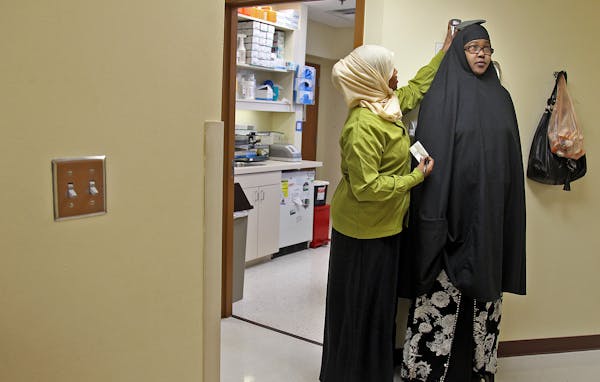Safety net clinics, which serve the Twin Cities' neediest neighborhoods, are arguing that Minnesota's quality rating system unfairly penalizes them for serving a poorer, sicker population.
The clinics are known for helping their patients not just with medical care, but with such basic needs as food, shelter and personal safety.
Quality measurements for more than 1,400 clinics are published on the website mnhealthscores.org, the result of a unique public-private partnership. In addition to shining a light on clinic performance, the scores are part of a long-term strategy to pay providers for quality rather than just quantity.
Most safety net clinics score below the state average for care of patients with asthma, diabetes and heart disease.
The problem, according to the clinics, is that the state's measurement system doesn't take into consideration the fact that their patient population is overwhelmingly sicker. Instead of measuring how well or poorly the providers are doing, the quality scores reflect the health of their patients, they say.
"We are definitely not opposed to measuring quality," said Deanna Mills, executive director of the Community-University Health Care Center in the Phillips neighborhood. "If I was going to measure quality, I would do it in a whole different way than we are being asked to."
This year, this Legislature passed a law requiring state agencies and the nonprofit MN Community Measurement, which shepherds the measurement system, to adjust the scores to account for the problems safety net clinics face.
But advocates say they are not optimistic that the changes will be made.
"This actually is the third time legislation has been passed since 2010 to get quality measures to take into consideration the patient characteristics that have an impact on the quality score," said Michael Scandrett, a health care consultant who represents the Minnesota Health Care Safety Net Coalition. "We should be there by now."
The president of MN Community Measurement, Jim Chase, said he's committed to addressing the safety net clinics' concerns. "I think they would like things to move faster," he said. "We are working on it, but it is not something that we can snap our fingers and have it happen."
Patients change, scores change
Dr. Lynne Ogawa knows firsthand how quality scores can be affected when her patients change.
A nearly 20-year veteran of family practice medicine, Ogawa started at a Minneapolis safety net clinic, then moved to a large metro health system, Fairview Health Services. Five years ago, she went back to a safety net clinic, the St. Paul-based West Side Community Health Services.
She saw her quality scores improve when she went to Fairview, then fall again when she moved to West Side.
"I didn't change. I'm the same doctor," Ogawa said. "My patient population changed."
Nearly two-thirds of her current patients do not speak English. As at other social net clinics, there are higher rates of smoking. Nearly 70 percent of patients live below the poverty line. About one-third of them still lack health insurance, despite historically low health insurance rates in Minnesota.
"We are still working hard to help our patients get healthy," Ogawa said. "It is just figuring out how to get them the best health within the constraints we have."
Sometimes that means taking care of problems that exist outside the clinic walls. Several clinics offer short-term rent payment assistance. Others help with finding housing or getting assistance fighting landlords who won't address the type of unclean living conditions that can be detrimental to asthma patients.
"We do what works best for the patients and the situation they are in," said Mills, of the Community-University clinic. "Sometimes that does transfer into a better medical outcome that can be measured, and sometimes it doesn't."
Besides reporting quality numbers to the state, Community-University reports quality data to the federal government. The clinic scores higher on the federal measures.
Fewer rewards ahead?
One problem with the state numbers is their use of composite measures. The state's diabetes score, for instance, comprises five separate measures, including blood glucose levels, blood pressure control and smoking cessation.
But safety net clinics have more patients who smoke. The rates can be as high as 50 percent for American Indians and 30 percent for black patients.
"You can have the best clinicians in the world and even the best smoking cessation program, but you are going to fail a significant percent of the time on that diabetes measure" because of smoking, said Scandrett. The same holds true for the state's heart care measure, which also relies on smoking cessation to achieve a high score.
"We don't want to be penalized because of the patients that we serve," said Jonathan Watson, director of public policy for the Minnesota Association of Community Health Centers.
The Minnesota Department of Human Services is already using the state quality measures in a test program that covers 200,000 people enrolled in Medical Assistance. Sixteen provider networks are eligible for bonus payments if they improve quality and reduce costs. Last year, the program saved taxpayers $61.5 million, according to DHS. By 2018, the agency hopes to expand the program to include one-half of the 1 million enrolled in Medical Assistance.
A network of 10 safety net clinics is participating in the program. In two years, those clinics have saved about $10 million in costs, according to Watson. Under an agreement with DHS, the network will receive about $5 million in rewards payments.
But as the program moves forward, it is unclear whether the clinics' low quality scores will make them ineligible for future rewards payments.
Glenn Howatt • 612-673-7192

A tale of 124 hoarded Minnesota cats has at least a hundred happy endings

Walz, St. Paul leaders urge support for copper wire theft bill: 'We've got to get in front of it'
Body of missing canoeist, 15, recovered from southwest Minnesota lake

High winds flipped a FedEx truck traveling on Bong Bridge in Duluth

